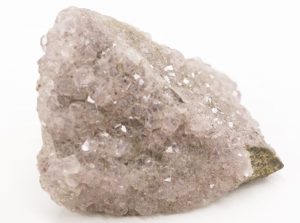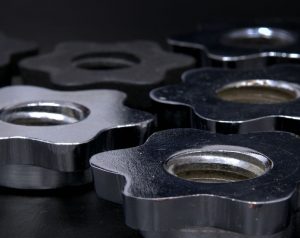D5.3 Ionic Compounds
Applying Core Ideas: Two Substances, Some Similarities, Some Big Differences


Compare iron, which melts at 1811 K (1538 °C), and calcium fluoride, which melts at 1691 K (1418 °C). Are the forces between atomic-level particles similar in iron and calcium fluoride? Write in your notebook an explanation of your answer to this question.
Consider some other properties of iron and calcium fluoride.
Iron has typical metallic properties: pure solid iron has metallic luster, is malleable, and conducts electricity.
Calcium fluoride has significantly different properties: as a solid it is brittle, does not look metallic, and does not conduct electricity; when molten, calcium fluoride does conduct electricity though.
It appears that these two substances have similar attractions between atomic-level particles, but quite different properties. We need a better atomic-scale model to make sense of these differences.
In metals, which have low effective nuclear charges (and low ionization energies), it is relatively easy to form positive ions within a sea of electrons so that attractions among the ions and the electrons hold the atoms together. What happens when an atom with a low ionization energy interacts with an atom with a large negative electron affinity? In such a case, transfer of one or more electrons from the atom with the low ionization energy to the one with the high electron affinity can be energetically favorable. For example, consider transfer of an electron from a Li atom to a F atom to form a cation and anion close together: an ion pair, Li+F–.
From the activity above, you’ve worked out that the formation of the ion pair is associated with a negative ΔE: the joined ion pair is lower in total energy (more stable) than the two atoms from which it formed.
The gain and loss of electron(s) in forming an ion-pair typically results in a full octet for the cation and anion. For example:
When a large number of ions form, anions and cations form a structure, called an ionic crystal lattice, where the total number of anions and cations together result in zero total electric charge. In this lattice, each anion has several cations as its nearest neighbors, and each cation has several anions as its nearest neighbors (see example in Figure below). This arrangement maximizes anion-cation attractions (smaller r results in lower Coulomb’s law energy) and minimizes anion-anion and cation-cation repulsions (greater r between anions and between cations). A compound made up of anions and cations is called an ionic compound and the overall attraction making an ionic crystal lattice stable is called ionic bonding.
For example, when sodium cations (Na+) and bromide anions (Br−) come together, the crystal lattice of the compound sodium bromide (shown in the figure above) contains one Na+ (green) for each Br− (violet). The chemical formula representing the part of the lattice shown in the figure is Na75Br75 because there are 75 Na+ and 75 Br− ions. The actual crystal is much larger, so the subscripts in the formula of a real crystal would be huge. A formula unit is a group of chemical symbols that indicates the smallest whole number ratio of ions of each kind that make up the substance, and is typically used as the formula for ionic compounds. Thus, the formula unit (and the formula) for sodium bromide is NaBr.
All chemical substances are overall electrically neutral. Thus, in an ionic compound, the positive charge from all the cations must equal to the negative charge from all the anions. In other words, the subscripts in a formula unit of an ionic compound must result in equal quantities of positive and negative charges. If we know the charges of the ions, then we can write the formula.
Some ions consist of a group of atoms with an overall charge. Examples include sulfate dianion, SO42−, dihydrogen phosphate anion, H2PO4−, and ammonium cation, NH4+. It is quite useful to be able to recognize such polyatomic ions and their charges. If you need to refresh your knowledge of polyatomic ions, use the reference table as you do the next two exercises.
Exercise: Ionic Compounds with Polyatomic Ions
Exercise: Formulas for Ionic Compounds
Please use this form to report any inconsistencies, errors, or other things you would like to change about this page. We appreciate your comments. 🙂

